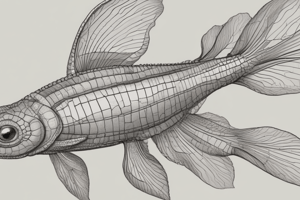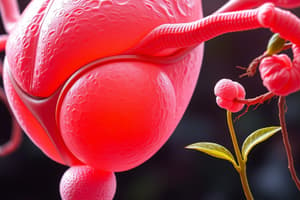Podcast
Questions and Answers
Which of the following is NOT a type of nutritional adaptation in plants?
Which of the following is NOT a type of nutritional adaptation in plants?
- Parasitism
- Symbiosis with Microbes
- Mycorrhiza
- Internal Fertilization (correct)
What is the main advantage of cross-pollination over self-pollination?
What is the main advantage of cross-pollination over self-pollination?
- It increases the genetic diversity of the offspring. (correct)
- It ensures that the offspring are genetically identical to the parent plant.
- It results in the production of more pollen.
- It allows plants to reproduce without the need for flowers.
What is the primary function of the stamens in a flower?
What is the primary function of the stamens in a flower?
- To produce pollen (correct)
- To protect the flower
- To produce seeds
- To attract pollinators
Which of these is a characteristic of a substrate feeder?
Which of these is a characteristic of a substrate feeder?
Which of these is an example of an oviparous animal?
Which of these is an example of an oviparous animal?
Which of the following organisms is an example of a filter feeder?
Which of the following organisms is an example of a filter feeder?
What is the difference between macronutrients and micronutrients in plants?
What is the difference between macronutrients and micronutrients in plants?
Which of these is NOT a reason why reproduction is important?
Which of these is NOT a reason why reproduction is important?
What is the main function of the small intestine in the digestive system?
What is the main function of the small intestine in the digestive system?
Which of the following are examples of heterotrophs?
Which of the following are examples of heterotrophs?
What is the function of spiracles in insects?
What is the function of spiracles in insects?
Which of the following is NOT a function of the transport system in organisms?
Which of the following is NOT a function of the transport system in organisms?
What is the role of lenticels in stems?
What is the role of lenticels in stems?
What is the process by which nutrients enter the bloodstream called?
What is the process by which nutrients enter the bloodstream called?
Which of the following is NOT a substance transported by the transport system?
Which of the following is NOT a substance transported by the transport system?
The transport system in humans primarily uses which of the following media?
The transport system in humans primarily uses which of the following media?
Which type of circulatory system is found in insects?
Which type of circulatory system is found in insects?
What is the primary function of red blood cells?
What is the primary function of red blood cells?
What is the process called where water is lost through stomata in plants?
What is the process called where water is lost through stomata in plants?
What is the primary function of the xylem in plants?
What is the primary function of the xylem in plants?
Which of the following is NOT a component of the human circulatory system?
Which of the following is NOT a component of the human circulatory system?
Which type of circulation moves deoxygenated blood to the lungs for oxygenation?
Which type of circulation moves deoxygenated blood to the lungs for oxygenation?
What is the primary function of the circulatory system in complex organisms?
What is the primary function of the circulatory system in complex organisms?
Why is gas exchange essential for life?
Why is gas exchange essential for life?
Which of these is NOT a type of asexual reproduction?
Which of these is NOT a type of asexual reproduction?
What is the primary advantage of sexual reproduction over asexual reproduction?
What is the primary advantage of sexual reproduction over asexual reproduction?
Which type of reproduction is most likely to lead to the development of a new species over time?
Which type of reproduction is most likely to lead to the development of a new species over time?
What is the role of root hairs in plant nutrition?
What is the role of root hairs in plant nutrition?
Which of these is an example of a heterotrophic organism?
Which of these is an example of a heterotrophic organism?
What is the primary function of phloem in plants?
What is the primary function of phloem in plants?
What is the main function of the process of pollination?
What is the main function of the process of pollination?
How does biodiversity influence the function of an ecosystem?
How does biodiversity influence the function of an ecosystem?
Flashcards
Reproduction
Reproduction
The creation of new organisms from existing ones, ensuring the continuation of species.
Asexual Reproduction
Asexual Reproduction
A method of reproduction where a single parent produces offspring that are genetically identical to itself.
Sexual Reproduction
Sexual Reproduction
A method of reproduction involving the combination of genetic material from two parents, resulting in diverse offspring.
Binary Fission
Binary Fission
Signup and view all the flashcards
Budding
Budding
Signup and view all the flashcards
Fragmentation
Fragmentation
Signup and view all the flashcards
Vegetative Propagation
Vegetative Propagation
Signup and view all the flashcards
Regeneration
Regeneration
Signup and view all the flashcards
Self-Pollination
Self-Pollination
Signup and view all the flashcards
Cross-Pollination
Cross-Pollination
Signup and view all the flashcards
Macronutrients
Macronutrients
Signup and view all the flashcards
Micronutrients
Micronutrients
Signup and view all the flashcards
Mycorrhiza
Mycorrhiza
Signup and view all the flashcards
External Fertilization
External Fertilization
Signup and view all the flashcards
Internal Fertilization
Internal Fertilization
Signup and view all the flashcards
Bulk Feeders
Bulk Feeders
Signup and view all the flashcards
Food Processing
Food Processing
Signup and view all the flashcards
Food Vacuole
Food Vacuole
Signup and view all the flashcards
Gastrovascular Cavity
Gastrovascular Cavity
Signup and view all the flashcards
Complete Digestive System
Complete Digestive System
Signup and view all the flashcards
Ingestion
Ingestion
Signup and view all the flashcards
Digestion
Digestion
Signup and view all the flashcards
Absorption
Absorption
Signup and view all the flashcards
Elimination
Elimination
Signup and view all the flashcards
Diffusion
Diffusion
Signup and view all the flashcards
Respiration
Respiration
Signup and view all the flashcards
Open Circulatory System
Open Circulatory System
Signup and view all the flashcards
Closed Circulatory System
Closed Circulatory System
Signup and view all the flashcards
Circulatory System
Circulatory System
Signup and view all the flashcards
Arteries
Arteries
Signup and view all the flashcards
Veins
Veins
Signup and view all the flashcards
Capillaries
Capillaries
Signup and view all the flashcards
Study Notes
Reproduction Overview
- Asexual reproduction produces offspring genetically identical to the parent. Methods include budding, fission, and fragmentation.
- Sexual reproduction combines genetic material from two parents, creating genetic diversity. A zygote forms.
- Asexual reproduction types include binary fission (division into two identical cells), budding (new organism from a bud), fragmentation (breaking into fragments that grow), and vegetative propagation (new plants from vegetative parts).
- Spore formation results in new individuals from spores (common in fungi). Self-pollination involves pollen fertilizing ovules within the same flower, while cross-pollination involves pollen transfer between different plants.
Ecosystem Function and Biodiversity
- Ecosystem function influences ecological balance. Species roles are essential (e.g., pollinators).
- Biodiversity is crucial for healthy ecosystems.
Summary of Nutrient Procurement and Processing
- Nutrients are substances for organism growth and maintenance.
- Autotrophs produce food using sunlight and chemicals, while heterotrophs obtain food by consuming other organisms.
Plant Nutrition
- Plants absorb nutrients from water through roots and atmospheric carbon dioxide.
- Plant chemical composition is mainly water (80-90%).
- Root hairs increase absorption surface area.
- Phloem transports sugars.
Nutritional Requirements for Plants
- Macronutrients are needed in large amounts (e.g., water, carbon dioxide).
- Micronutrients are required in smaller amounts.
Nutritional Adaptations in Plants
- Symbiotic relationships with microbes (e.g., mycorrhizae) allow plants to gain nutrients and microbes gain resources.
- Some plants are parasitic, absorbing nutrients from hosts.
Animal Nutrition
- Animal nutritional needs include carbohydrates, proteins, and fats.
- Calories measure energy content.
- Organisms use various feeding mechanisms (e.g., substrate feeding, filter feeding).
Gas Exchange and Respiration
- Gas exchange is essential for life; it provides oxygen for metabolism and removes carbon dioxide.
- Diffusion occurs across moist membranes.
- Respiration is the process where organisms use oxygen and produce carbon dioxide.
- Plants and animals have different systems for gas exchange (e.g., stomata, lungs).
Circulatory Systems
- Closed circulatory systems circulate blood within vessels (e.g., humans).
- Open circulatory systems circulate body fluid directly into tissues (e.g., insects).
- Human circulatory system components include the heart, blood, and blood vessels (arteries, veins, capillaries).
- Blood carries oxygen, nutrients, and waste.
- Pulmonary circulation moves deoxygenated blood to lungs for oxygenation.
- Systemic circulation distributes oxygenated blood to tissues.
Studying That Suits You
Use AI to generate personalized quizzes and flashcards to suit your learning preferences.
Related Documents
Description
This quiz covers key concepts in biology, focusing on reproduction methods, including asexual and sexual reproduction, as well as the importance of ecosystem function and biodiversity. Test your knowledge on the roles of species and nutrient processing in maintaining ecological balance.




